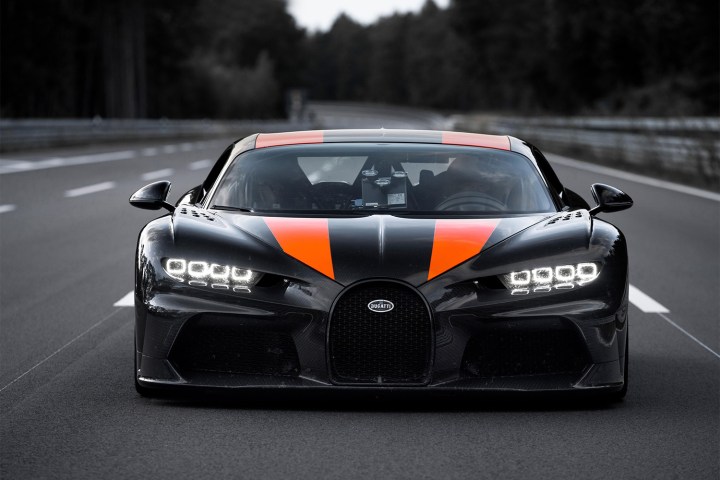
“It looks easy when you see it,” British pilot Andy Wallace told me in disbelief as he watched footage of himself reaching 304 mph in a Bugatti Chiron. He was right; it did look easy. It was almost video game-like. Wallace explained getting there required months of preparation, endless wind tunnel testing, the right tires, and a tremendous amount of tech.
Boasting 16 cylinders, four turbochargers, and 1,600 horsepower, the Bugatti Chiron Super Sport 300+ was developed with speed in mind. Engineers designed every part of the car to cruise faster than a small plane. The record-setting car rode on a stock suspension, according to Wallace, and it used normal brakes. Only the tires had to be upgraded; that’s where Michelin stepped in. The company already makes tires for the standard Chiron, so it already knew what it was working with.
“We first had to know the limit of the current tire. We had to reinforce its belt, and the main challenge was to know how to test it. We needed to define the right conditions, because those speeds are beyond all known boundaries. We had to define new tools for the simulations, and new kind of tests,” explained Michelin engineer Benjamin Vilpert in an interview with Digital Trends. His team headed to Charlotte, North Carolina, where the French firm helps NASA test tires for the space shuttle, to make sure the tires it developed for Wallace’s high-speed run wouldn’t turn into confetti. And, luckily, they didn’t.

Michelin tested the tires to 317 mph, though Vilpert told me they can handle more. “There is no place on earth where you can reach the limits of the tires,” he affirmed. The testing regime involved endless computer simulations, and high-speed runs on a dynometer. Technology has gotten so precise that the Chiron never touched down in Charlotte. The Pilot Sport Cup 2 tires Michelin developed weren’t mounted on the car until a week before it started testing on the Ehra-Lessien track in Germany.
“There is no place on earth where you can reach the limits of the tires.”
Computer simulations also helped Bugatti find out how the Chiron would handle as it approached — and exceeded — 300 mph. Wallace said testing started in a wind tunnel, where speeds of up to 65 yards per second are possible. He covered about 149 yards per second on the track, so digital tools filled in the gap. They helped engineers shape the car’s aerodynamic profile, including the extended rear end which keeps the car planted on its four wheels by adding drag.
The technology that went into preparing the Chiron for its high-speed run gave Wallace the confidence to keep the pedal to the floor. “It’s fantastic to work with really clever engineers. It’s great to see every part of the puzzle that needs a solution has got a group of guys in charge of it,” he told us. “Of course, there’s a risk involved, but you have confidence that the people you’re working with are top-notch. In the end, you’re in the best place you can be,” he concluded.
Bugatti secured its spot in the history of speed by becoming the first carmaker to break the 300-mph barrier with a production car.
“It’s pretty cool,” he said with a smile. “It certainly gets your attention, everything is happening very quickly. If you allow yourself to look around, you see how much scenery is coming towards you.”



